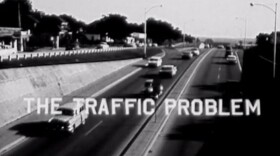Capital Metro isn't yet sure whether to favor light rail or rapid bus service as it expands its network, but an analysis shows adding trains would cost more, while buses would move fewer people.
The projections were released ahead of a joint meeting Wednesday afternoon between the Capital Metro Board of Directors and the Austin City Council. It's part of a process to come up with a plan to present to voters for a potential bond election next year.

The centerpiece of Capital Metro’s plan is to have two dedicated routes that don’t mix with regular car traffic, known as the Orange and Blue Lines. The lines could operate on street level for their entire length, or be elevated and underground for portions of the route.
The Orange Line would run in the Guadalupe/Lamar and South Congress corridors, with potential extensions to Tech Ridge and Slaughter. The Blue Line, would run from near the UT campus through downtown and out to the airport, with a potential extension to ACC Highland.
“Whether it is at street level, whether it’s elevated, what that configuration could be, depending on what the availability is, real estate, things of that nature, that’s one component,” said Dave Couch, project manager for Project Connect. “The second component is what is that mode, what is the vehicle that will run on that infrastructure: is it going to be light rail? Will it be bus? That are open questions.”
The answers to those questions will determine how much the plan costs.
- For light rail trains on both the Orange and Blue Lines, Cap Metro projects costs would run between $6.3 billion and $8.1 billion
- For bus rapid transit only, Cap Metro projects costs would run between $3.2 billion and $5.5 billion.
- Putting both lines underground in downtown Austin would add another $1.9 billion to $2.3 billion to the costs.
Mayor Steve Adler said at the work session that while some may balk at the potential price tag for a full buildout of Project Connect, it will take a big plan to solve the region’s mobility issues.
“What that number represents is an opportunity to actually talk about how much we want generational, transformative change in our city,” Adler said.
Other officials cited the examples of regions like Denver, Minneapolis and Seattle, which have undertaken large transit projects in recent years.
“We’re retrofitting a city, and it’s going to cost a lot of money,” said District 1 Council Member Natasha Harper-Madison. “We have to go big, if we’re going to do it well.”
While bus rapid transit would cost less overall, light rail trains would have a higher capacity. For both the Orange Line and the Blue Line, Cap Metro gave estimates for service running either on the street-level or partially above traffic. Overall, it projects more people would ride on an elevated line.
“We have to make a decision as a community with a limited amount of resources that yes, we can build BRT cheaper, we will be able to build BRT faster, but you will run up to the theoretical capacity much earlier than you will with LRT," said Capital Metro President and CEO Randy Clarke. "That is one of the biggest decisions the whole group will have to make.”
On the high end, Capital Metro projects running light rail on the Orange Line could have a daily ridership of 74,000 passengers by 2040, with 66,000 passengers on buses.
On the Blue Line, it would be 52,000 passengers on rail, with 45,000 on buses.
Andrew Clements with the Austin Coalition for Transit said he and other advocates want to better know how Cap Metro came up with its projections.
"It’s not such a clear cut close call between light rail and bus rapid transit, especially for the Orange Line," Clements said. "We actually still think there’s some real strong reason to go with light rail, and we’d like for more accurate data to come out.”
Capital Metro would be seeking federal funding for the projects, would could account for 40% of the dollars needed to complete them. The rest would come from local funding, if voters approve the bond.
The long-range plans also include a new commuter rail line, called the Green Line, which would run between Downtown Austin to Manor and Elgin, as well as expansion of the existing MetroRapid bus service. Capital Metro would also add neighborhood connectors, similar to its current Pickup service, in areas where fixed route bus service isn’t practical.
The two bodies will meet jointly once again in January to discuss financing the transit plan, with final decisions on a proposed referendum expected sometime in the spring.
Got a tip? Email Samuel King at samuel@kut.org. Follow him @SamuelKingNews.
This story has been updated.
________________________________
Read the whole Cap Metro analysis below






